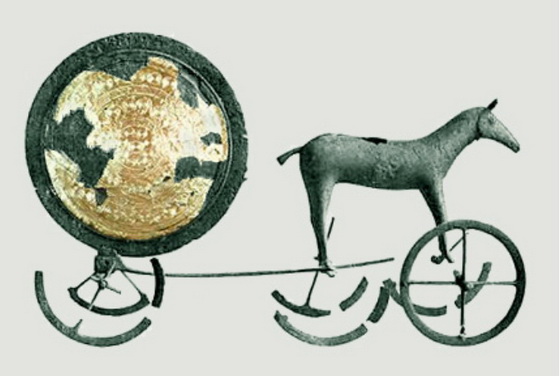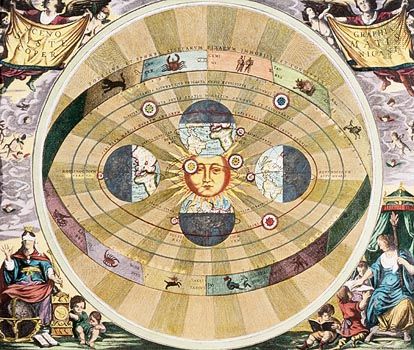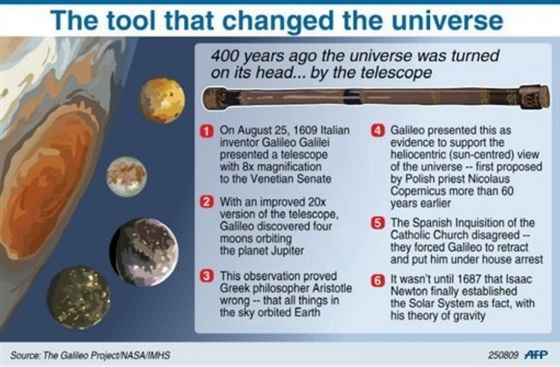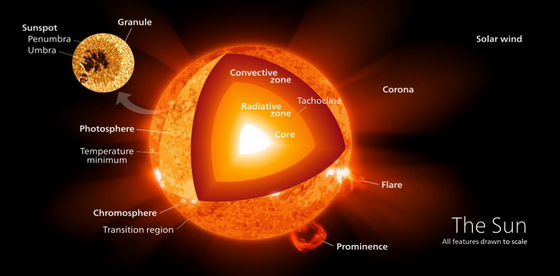Part 12: The vast majority of our Solar System’s mass, 99,9 %, is in the Sun, with most of the remaining mass contained in Jupiter. For the four terrestrial planets together, including our Earth, less than 0,002% is left.
For many thousands of years, humanity, with a few notable exceptions, did not recognize the existence of the Solar System. People believed the Earth to be stationary at the centre of the universe and categorically different from the divine or ethereal objects that moved through the sky.

Although the Greek philosopher Aristarchus of Samos had speculated on a heliocentric reordering of the cosmos, Nicolaus Copernicus was the first to describe a mathematically predictive heliocentric system in 1543: De revolutionibus orbium coelestium.

A 17th-century Dutch engraving of the Copernican solar system
In the 17th-century, Galileo Galilei, Johannes Kepler and Isaac Newton developed an understanding of physics, that led to the gradual acceptance of the idea that the Earth moves around the Sun and that the planets are governed by the same physical laws that govern the Earth. The invention of the telescope led to the discovery of further planets and moons. Improvements in the telescope and the use of unmanned spacecrafts have enabled the investigation of geological phenomena, like mountains and craters and seasonal meteorological phenomena, such as clouds, dust storms and ice caps, on the other planets.

The Solar System formed 4,6 billion years ago from the gravitational collapse of a giant interstellar molecular cloud, sometimes called a stellar nursery, the density and size of which permit the formation of molecules, most commonly molecular hydrogen, H2.

The sun’s general structure. At the core the energy is generated by nuclear fusion. This energy is transported outwards by radiation, and then by convection through moving plasma.
The vast majority of the system’s mass is in the Sun, with most of the remaining mass contained in Jupiter. The Sun contains 99,86% of the system’s known mass and dominates it gravitationally.

Size comparison of the Sun and the planets
The Sun’s four largest orbiting bodies, the giant planets, account for 99% of the remaining mass, with Jupiter and Saturn together comprising more than 90%. The remaining objects of the Solar System, including the four terrestrial planets, the dwarf planets, moons, asteroids and comets, together comprise less than 0,002% of the Solar System’s total mass.

The eight planets of the Solar system (by decreasing size) are Jupiter Saturn, Uranus, Neptune, Earth, Venus, Mars and Mercury.
The Sun is composed of roughly 98% hydrogen and helium. Jupiter and Saturn possess atmospheres composed of roughly 99% of these elements.
A composition gradient exists in the Solar System, created by heat and light pressure from the Sun.
Those objects closer to the Sun, which are more affected by heat and light pressure, are composed of elements with high melting points.
Objects farther from the Sun are composed largely of materials with lower melting points.
The four smaller inner planets, Mercury, Venus, Earth and Mars, are terrestrial planets, being primarily composed of rock and metal. The four outer planets are giant planets, being substantially more massive than the terrestrials. The two largest, Jupiter and Saturn, are gas giants, being composed mainly of hydrogen and helium. The two outermost planets, Uranus and Neptune, are ice giants, being composed largely of substances with relatively high melting points compared with hydrogen and helium, called ices, such as water, ammonia and methane. All planets have almost circular orbits that lie within a nearly flat disc, called the ecliptic.
The Solar System also contains smaller objects. The asteroid belt, which lies between Mars and Jupiter, mostly contains objects composed of rock and metal, like the terrestrial planets. Beyond Neptune’s orbit lie the Kuiper belt and scattered disc, populations of trans-Neptunian objects composed mostly of ices, and beyond them a newly discovered population of sednoids. Within these populations are several dozen to possibly tens of thousands of objects large enough to have been rounded by their own gravity. Such objects are categorized as dwarf planets. Identified dwarf planets include the asteroid Ceres and the trans-Neptunian objects Pluto and Eris. In addition to these two regions, various other small-body populations, including comets, centaurs and interplanetary dust, freely travel between regions.
Six of the planets, at least three of the dwarf planets and many of the smaller bodies are orbited by natural satellites, usually termed moons after the Moon. Each of the outer planets is encircled by planetary rings of dust and other small objects.
The solar wind, plasma flowing outwards from the Sun, creates a bubble in the interstellar medium known as the heliosphere. The heliopause is the point at which pressure from the solar wind is equal to the opposing pressure of interstellar wind; it extends out to the edge of the scattered disc. The Oort cloud (named after the Dutch astronomer, professor Jan Hendrik Oort, also known as the ‘Great Oak of Astronomy’), which is believed to be the source for long-period comets, may also exist at a distance roughly a thousand times further than the heliosphere.

Thanks to Wikipedia for their posting of the Solar System.
 Shanti is a regular contributor to Osho News
Shanti is a regular contributor to Osho News
All articles of this series can be found in: At Home in the Universe




Comments are closed.